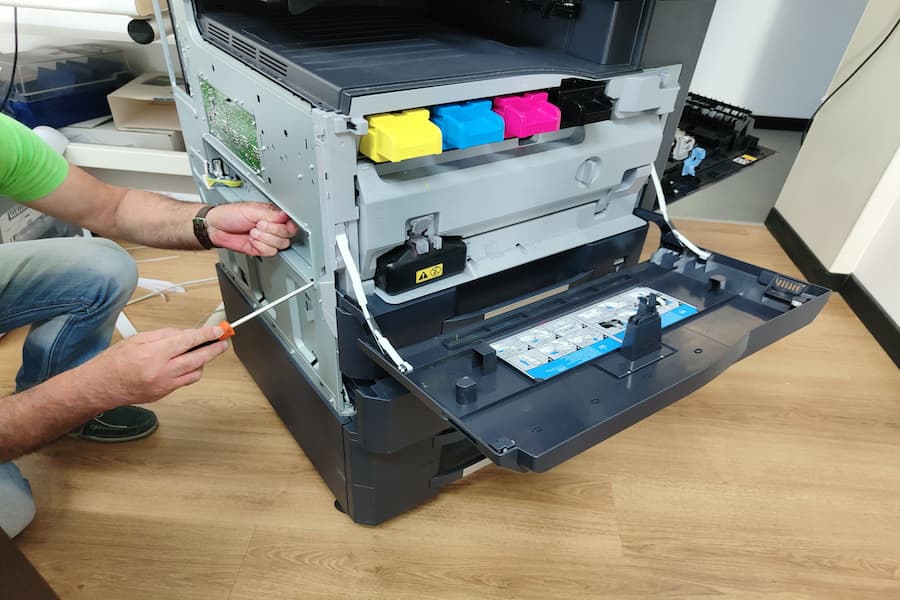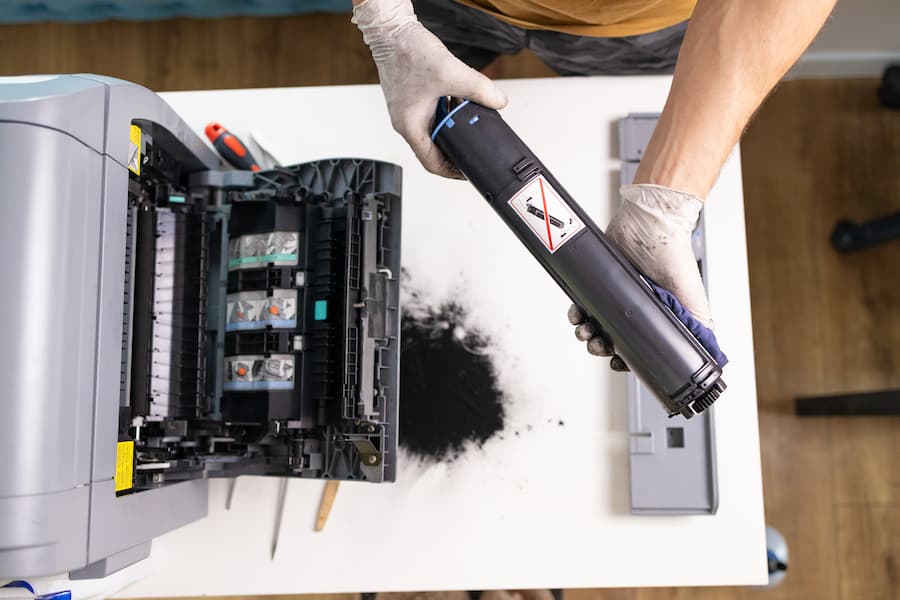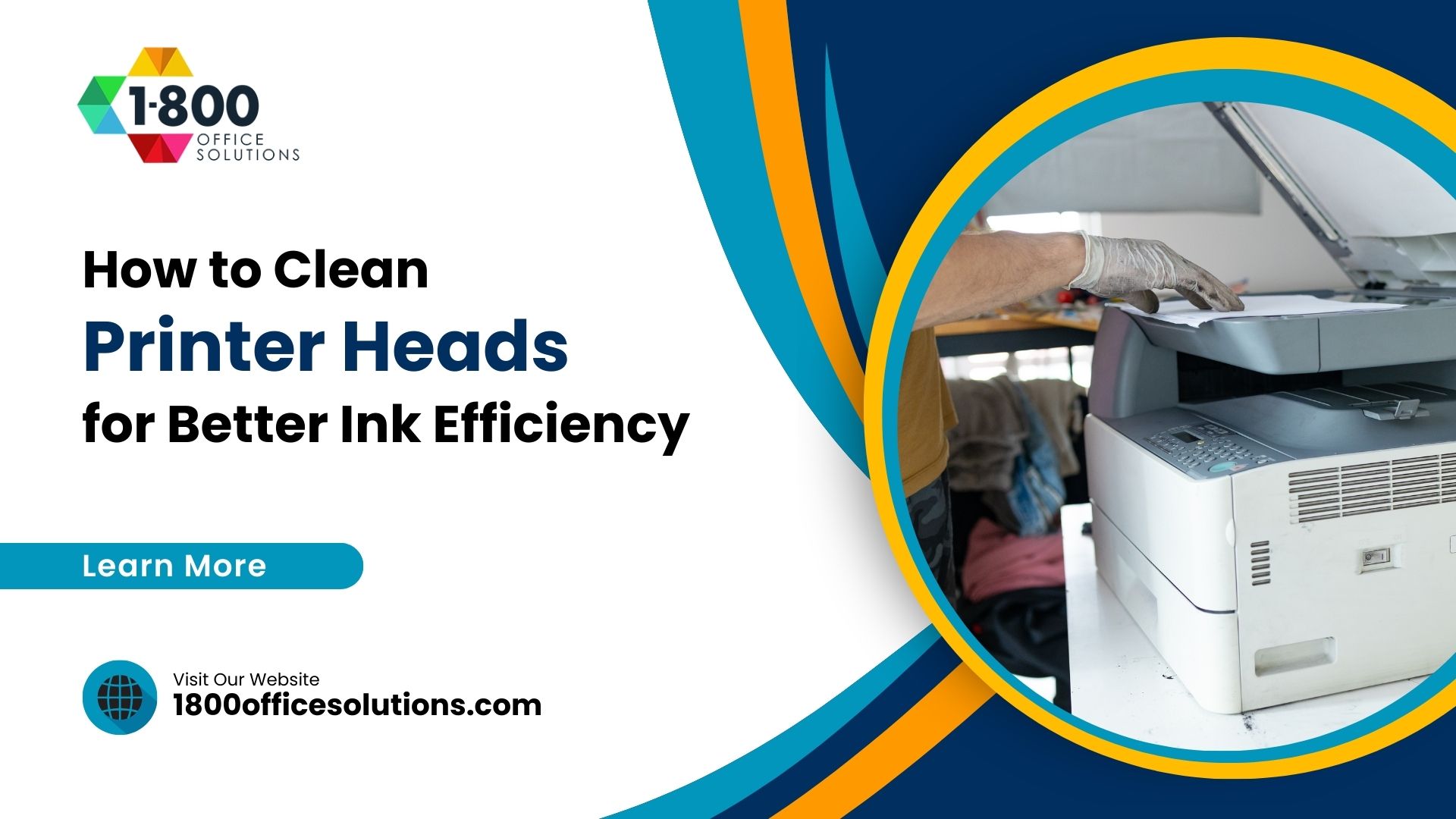The Dos and Don’ts of How to Clean Printer and Copiers
How to Clean Printer?
The printer has become an essential part of any office. Without it, productivity and efficiency would be greatly reduced. To ensure your printer’s longevity and performance, it’s important to take the time to clean it regularly. But how do you go about cleaning printers and copiers?
Inkjet, laser and toner printers all require different cleaning methods. Inkjet printer nozzles can easily become clogged, reducing print quality. To prevent this, you can run a nozzle check and a cleaning cycle. If your cartridges are starting to smudge, you may need to clean the print head using a lint-free cloth or swab.
For laser printers, use a damp cloth or compressed air to remove any dust or debris inside the printer. For toner and cartridge printers, we recommend removing the paper tray, then using a dry cloth to clean the entire roller and pick off any visible dust. For any type of printer, make sure to use lint-free cloths and isopropyl alcohol so you don’t damage any internal components.
Before you begin cleaning, make sure to check the printer’s manual for specific instructions. We’re committed to helping you keep your printer clean and running well until 2023 and beyond.
Cleaning the Outside of Your Printer
The dos and don’ts of cleaning the outside of your printer are essential for optimal performance. Before you begin, be sure to check your printer model’s manual for specific instructions. Generally speaking, you’ll want to start with a lint-free cloth and isopropyl alcohol to gently wipe away smudges and visible dust. If you have an Epson printer, you may even be able to run a head cleaning or automatic cleaning function. To test the print quality, print a nozzle check pattern or a test page.
The Dos
Now that you know the rules for cleaning the outside of your printer, it’s time to get to work. It’s important to take the proper steps and use the right products to make sure your printer is properly cleaned and maintained. Here are the dos and don’ts when it comes to cleaning your printer’s exterior.
The Dos:
- Make sure the device is powered down and unplugged before cleaning.
- Use appropriate cleaning agents. Our technicians use Isopropyl Alcohol to gently wipe down machines. Most anti-bacterial wipes are acceptable when cleaning your machine, including the touch screen, but check to make sure that alcohol is the only ingredient.
- Spray the cleaning agent onto a lint-free cloth/rag and then wipe surfaces.
- Cloths/rags should be disposed of after one use.
- Only use glass cleaner on the plate glass surface and wipe with a lint free cloth.
- Wait until surfaces are dry before plugging the device back in.
Cleaning your printer is a delicate process that requires special attention to detail. It’s important to remember the dos when it comes to cleaning your printer’s exterior.
First, it’s essential to turn off the printer and unplugging it before you start cleaning.
The Don’ts
When it comes to cleaning your printer, there are several don’ts you should be aware of. First, never use common cleaning products that contain bleach, ammonia or other harsh cleaning solvents. These types of products can discolor the surface of touchscreens and damage a printer, copier or multifunction device (MFD).
Additionally, avoid using wet wipes and other consumer products that contain ingredients other than alcohol which can damage machines. It’s also important not to spray cleaning agents directly on the device, as getting liquid inside the device could damage the internal components.
It’s also important to avoid:
- Applying liquids directly to the device: Liquid can cause damage to the internal components.
- Using wet wipes or other consumer products that contain ingredients other than alcohol: These can damage your device.
- Using extremely damp cloths or disinfectant wipes to clean the device: The excess liquid can damage your printer.
- Allowing liquids to sit or pool on the area being disinfected for more than a few seconds.
- Using rough paper towels or cloths to dry the glass or screens of your devices: This can cause scratches to the surface.
Should I Clean the Inside of a Printer?
If you’ve already cleaned the outside of your printer and you’re wondering if you should clean the inside of your printer as well, the answer is maybe. Opening up the inside of a printer can void the warranty, cause printer damage, and create a mess that’s difficult to clean up. So, unless you’re an experienced printer specialist, it’s best to leave internal cleaning to the professionals.
If you want to try cleaning the inside of your printer, first check your printer manual for specific instructions. Some printer models have an automatic cleaning function that can be found in the printer’s control panel. You can also contact an authorized dealer to inquire about cleaning services and printer maintenance tips.
If your printer has removable paper rollers, you can clean these with a lint-free cloth dampened with isopropyl alcohol. This helps to prevent paper jams and maintain the printer’s performance. For more serious problems like excess ink or poor print quality, it’s best to replace the paper tray and ink cartridge. To check if the ink cartridge needs to be replaced, print a test page to see if the printout is smudged or blurry.
Inkjet printers and laser printers require regular maintenance, such as cleaning the printhead, as well. Depending on the printer model, you may need to manually clean the printheads or run a nozzle check to determine if the nozzle needs to be cleaned. To manually clean the printhead, turn off the printer and remove the paper tray and ink cartridge.
How Do I Clean My Printer by Itself?
Now that you know why it is important to clean the inside of a printer, you may be wondering how to do it. Fortunately, there are several methods of cleaning a printer that you can use to ensure optimal print quality.
The first step is to turn the printer off and unplug it from the power source. Then, you’ll want to use a lint-free cloth and a small amount of isopropyl alcohol to clean the paper rollers. If you want to clean the paper feed, you can use a damp cloth to wipe out any dust or debris. For a more thorough cleaning, you may need to remove the paper tray and use a swab and compressed air to remove any visible dust.
Once you’ve wiped down the interior surfaces of the printer, you can turn it back on and run the cleaning function. To do this, you’ll need to access the printer software and select the printhead cleaning option. The printer will then run a cleaning cycle and the power light will stop flashing when it’s complete.
It’s also important to remember that printers need regular maintenance in order to function properly. You may want to print a test page to see how well the printer prints or run a nozzle check pattern to detect any clogs. You should also check the manual for your printer model for any specific instructions on how to clean the entire printhead. When you’re done cleaning your printer, make sure to leave it alone and allow it to completely dry.
How Do I Clean the Ink in My Printer?
Now that you have a clean printer, it’s time to tackle the ink. Cleaning the ink in your printer is essential to keep your printer in optimal condition, producing high-quality prints. To begin, turn off the printer and wait until the power light stops flashing. Before cleaning the ink, it is important to remember a few key cleaning tips: always use distilled water instead of tap water, never submerge the printer in water, and use lint-free cloths or swabs to avoid damage to the internal components.
The ink is typically located in a cartridge or printhead, depending on your printer model. If you have an inkjet printer, you can use a damp cloth or swab with either isopropyl alcohol or distilled water to clean the printhead. Make sure to remove any dust or debris from the area before cleaning. You can also run a nozzle check pattern or a cleaning cycle to help clear any clogs. For laser printers, you may need to manually clean the printheads, which requires specific instructions depending on the model of your printer.
It is important to remember to never submerge your printer in water or leave it alone with any liquid. Additionally, never use a dry cloth to clean your printer, as this could damage the internal components. You should also avoid using any type of paper product, such as a paper towel or tissue paper, to clean your printer as it may cause smudges or poor print quality. When you have finished cleaning the ink, you should run a test page to see if the print quality has improved.
Conclusion
It is essential to refer to the manual of your specific printer model and follow the specific instructions for cleaning and maintenance. Printer maintenance is an essential part of keeping your printer running smoothly and ensuring quality printouts. When cleaning printers and copiers, always turn off the printer before cleaning and take great care when cleaning internal components.
Use lint-free cloths, isopropyl alcohol, and compressed air to remove any dust or debris. Use distilled or filtered water instead of tap water to clean the ink and never submerge the printer in water. If you follow these do’s and don’ts, you can ensure that your printer and copier are always running in peak condition and producing quality prints.












